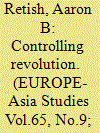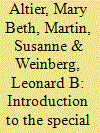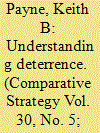| Srl | Item |
| 1 |
ID:
124311


|
|
|
|
|
| Publication |
2013.
|
| Summary/Abstract |
This essay is a study of how Soviet jurists and rural citizens attempted to understand and control illicit social violence during the Civil War and its immediate aftermath in the rural courts. It examines how Soviet leaders, people's courts and criminologists understood the role of the courts in controlling violence and how decisions of local courts actually limited the effects of the violence of revolution and civil war. It underscores the complexity of violence and the need to understand state and peasant attempts to control social violence in an age marked by political, state violence.
|
|
|
|
|
|
|
|
|
|
|
|
|
|
|
|
| 2 |
ID:
120316


|
|
|
|
|
| Publication |
2013.
|
| Summary/Abstract |
At a White House banquet held in his honor in March 1954, Winston Churchill observed that it was better to "jaw-jaw" than "war-war." In the Cold War atmosphere of the time (Stalin had died the previous year), Churchill was maintaining that talking with the Soviet leadership was better than a nuclear confrontation between the two superpowers. Who would argue otherwise?
|
|
|
|
|
|
|
|
|
|
|
|
|
|
|
|
| 3 |
ID:
108937


|
|
|
|
|
| Publication |
2011.
|
| Summary/Abstract |
During the Cold War, academic theorists and senior U.S. policy makers planned strategies of nuclear deterrence according to a particularly narrow application of the rational actor model. Their assumptions were that the Soviet leadership would make decisions pertinent to deterrence per an instrumental rationality, and that the parameters of that rational decision making would be bounded by a familiar and largely Western worldview with regard to perceptions, values, goals, and behavioral norms. The fundamental problem with this narrow application of the rational actor model is that it typically does not take into account a wide range of factors that can shape decision making decisively and vary widely across time, place, and opponent.
|
|
|
|
|
|
|
|
|
|
|
|
|
|
|
|